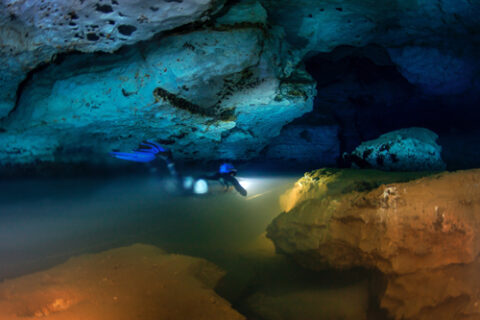“The sample he sent back to us was so interesting we knew we had to mount an expedition.”
In 2009 geomicrobiologist Jennifer Macalady got a phone call from a cave diver in the Dominican Republic who told her about a cave there with amazing curtains of slime. Her first thought was, “Who is this crackpot?” but she sent him a sample kit. “The sample he sent back to us was so interesting we knew we had to mount an expedition,” Macalady told Eos Monday. Macalady discussed the findings about these slime curtains in a talk Sunday at the Geologic Society of America’s 2015 meeting in Baltimore.
During the expedition 2 years later, Macalady, who is with Pennsylvania State University in University Park, and her colleagues enlisted the aid of divers, whose video of their underground explorations shows rust-colored fronds of slime. These fronds descend from the ceiling and walls of some saltwater-filled chambers of a flooded cave in the country’s southeast called Manantial del Toro. Although the cave contains both fresh water and salt water, the slime is found only in the salt water. To Macalady, who recognized the icky drapery as colonies of microbes living in an ooze of their own secretions, the cave coatings resemble “an inside out teddy bear.”
Rusty Clue
Whereas the challenge and exotic beauty of Manantial del Toro attracts explorer-divers, the metabolisms of the slime curtains’ microbes lured Macalady. The microbial communities that inhabit these fingers of slime are specialized not only for nitrogen cycling but also iron cycling. The researchers used DNA analyses to identify the microbes that process nitrogen by taking ammonium and transforming it into nitrite. However, that step is only part of the nitrogen cycle. Macalady and her colleagues have yet to identify the microbes involved in the iron cycling, but they know that this process occurs because the slime’s rust color indicates iron oxidation.
Could a previously undiscovered microbe capable of both reducing nitrate and oxidizing iron hang from the walls of Manantial del Toro?
From what the researchers can tell so far, the slime curtains aren’t taking two of the metabolic steps needed to completely use nitrogen and iron. The first is a pathway that would reduce nitrate and create ammonium, which the microbes then consume again to make nitrite. The second missing piece is a way to oxidize iron (II)—which is soluble and can enter the caves in water—into iron (III), which is insoluble and clings to the slime, giving it a rusty color.
Macalady said that organisms can separately perform those processes, but they don’t know of one organism that can do both. Could a previously undiscovered microbe capable of both reducing nitrate and oxidizing iron hang from the walls of Manantial del Toro? Macalady is quick to point out that her team has yet to find an answer to that tantalizing question.
Filter Hypothesis

The scientists are also investigating whether the slime might act as a filter and remove nitrogen pollution from water passing through. Manantial del Toro, 3.4 kilometers (2.1 miles) long, is a submerged karst system, a network of interconnected chambers that formed as soluble rocks dissolved. Its waters connect the land and the Caribbean Sea, so nitrogen and other pollutants from human fertilizers or sewage can pass through the cave into the surrounding coastal zone, where fragile coral reefs and sea grasses live.
The nitrogen cycling these slime curtains perform is important to understand, Macalady said, because “nitrogen pollution is famous for messing up coastal ecosystems,” with algal blooms being one consequence. She said that on her team’s next expedition, they aim to measure the flux of water leaving the cave, how much nitrogen escapes into the sea, and if there’s any impact on the surrounding ecosystem.
“The ability of microorganisms to remove nitrate as a contaminant, or even ammonia as a contaminant in water, is real,” said Annette Engel, a geomicrobiologist at the University of Tennessee, Knoxville, who is not involved in the work at Manantial del Toro.
A Growing Field
Because of the dangers of cave exploration, the field of cave microbiology is relatively small. From the 1940s through 2014, researchers have published less than a thousand papers in this field, according to Engel. But with dive and caving technology improving the safety of such excursions, the study of cave microbes is growing.
Microbes inhabit cave systems worldwide, both on land and submerged under water. Some come in golds that glitter when water droplets bead on the biofilm’s surfaces, others in azure blues that cling to cave walls. And then there are the rust-colored fronds of Manantial del Toro. “We think slimes will be there, and be conspicuous, wherever there is enough chemical energy to support them. If you feed them, they will come,” said Macalady.
—Cody Sullivan, Writer Intern
Updated on 5 November 2015 to correct inaccuracies about when scientific papers first appeared in cave microbiology, and the number of papers published overall in the field.
Citation: Sullivan, C. (2015), Cave-dwelling “slime curtains” cycle nitrogen and iron, Eos, 96, doi:10.1029/2015EO038909. Published on 4 November 2015.
Text © 2015. The authors. CC BY-NC 3.0
Except where otherwise noted, images are subject to copyright. Any reuse without express permission from the copyright owner is prohibited.

